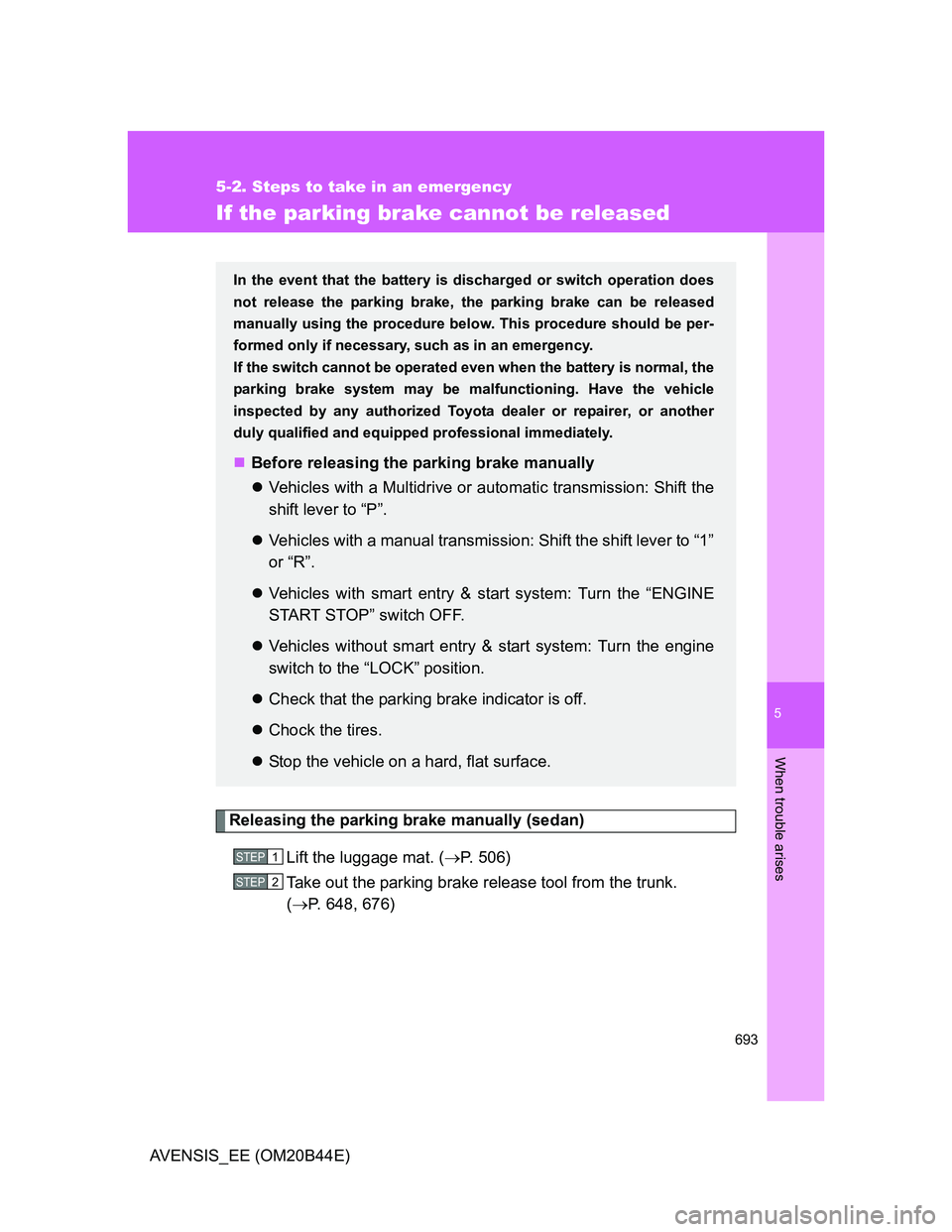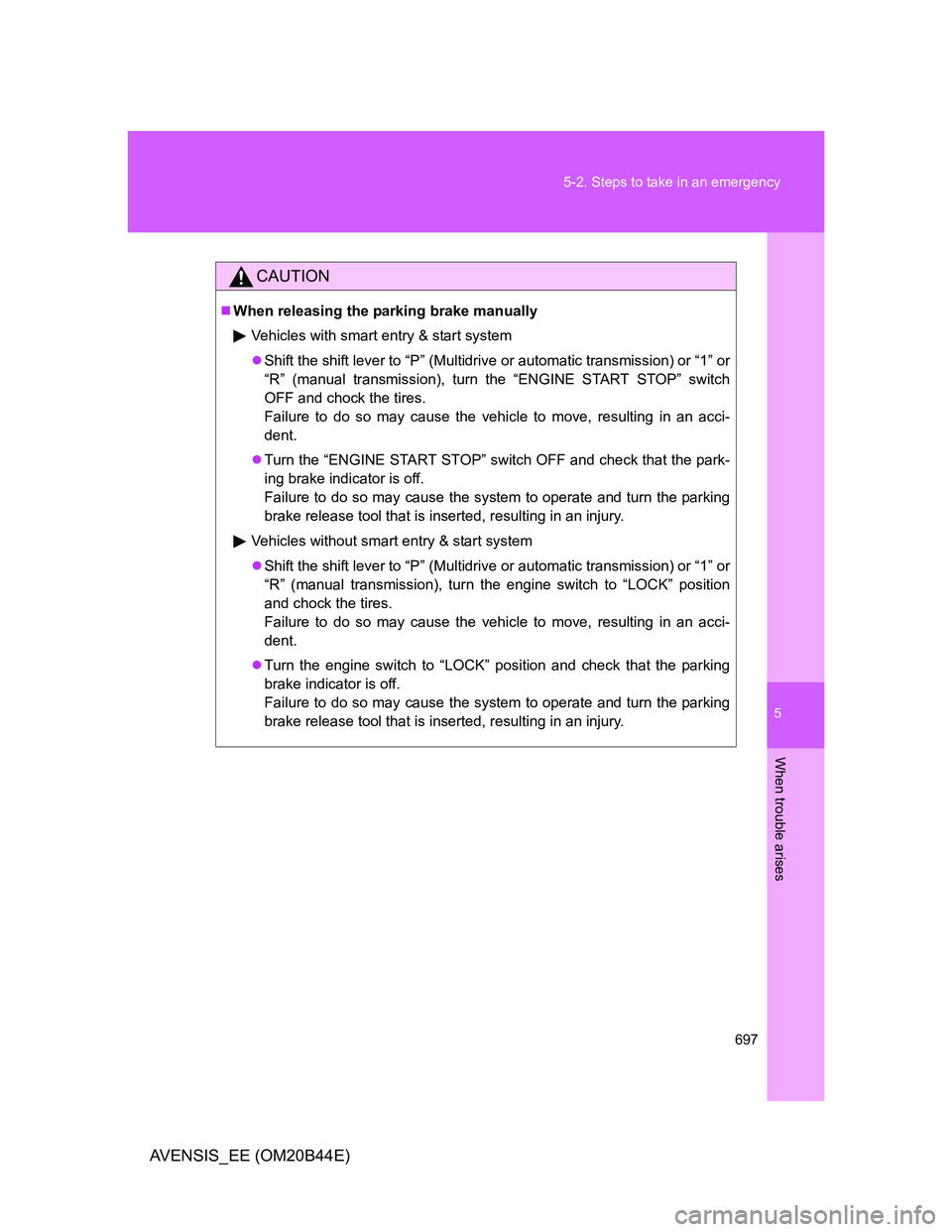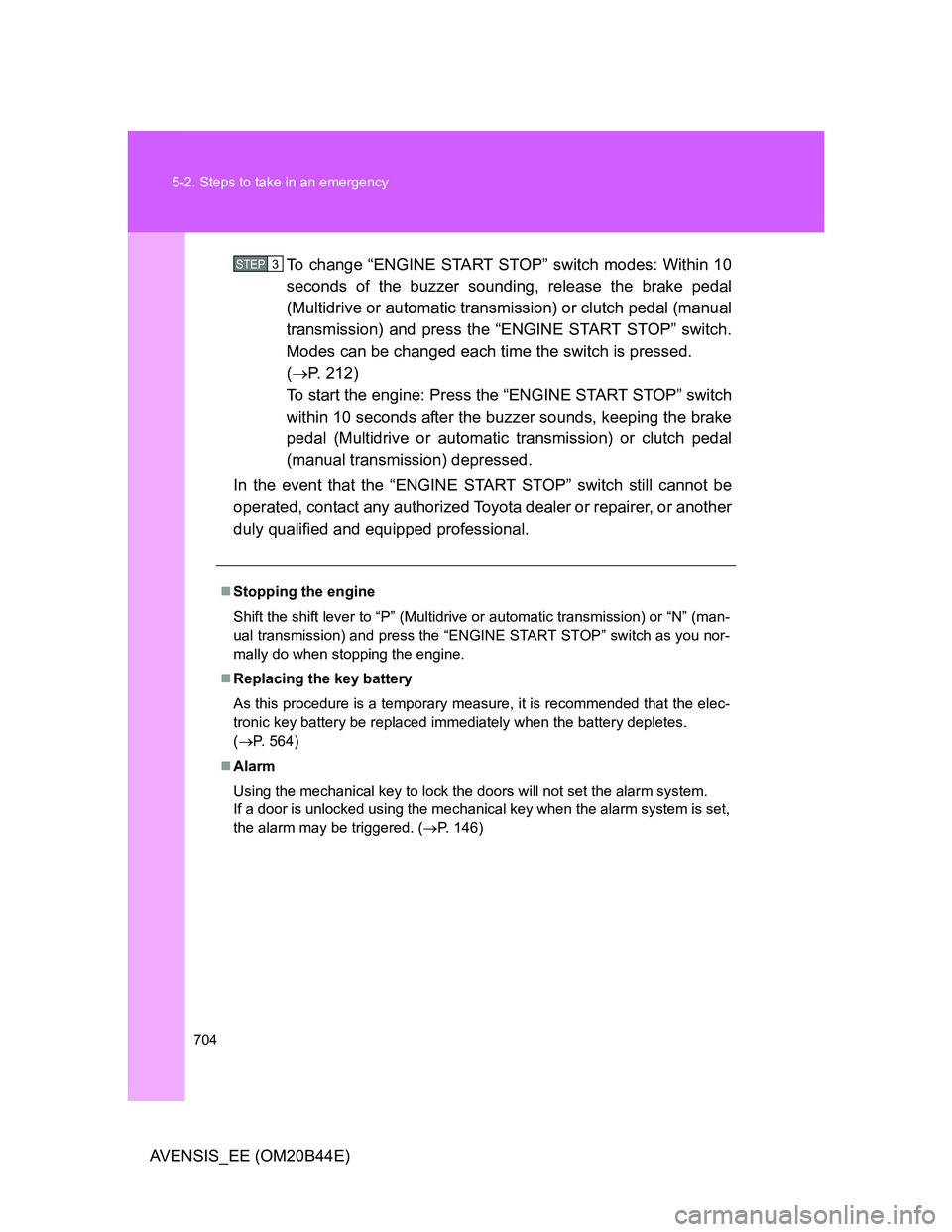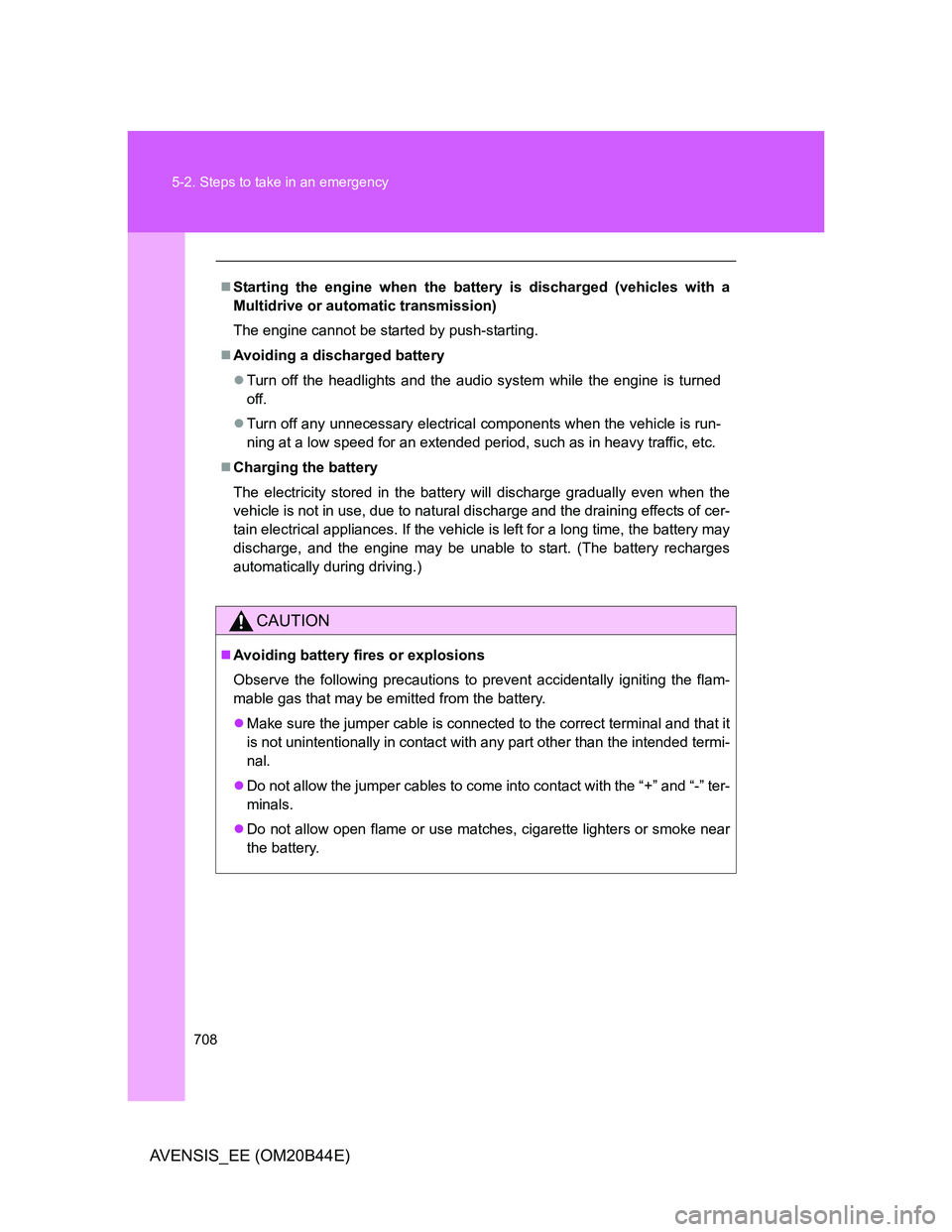Page 692 of 772
692
5-2. Steps to take in an emergency
AVENSIS_EE (OM20B44E)
If the shift lever cannot be shifted from “P”
For vehicles with Multidrive or automatic transmission: If the shift
lever cannot be shifted with your foot on the brake, there may be a
problem with the shift lock system (a system to prevent accidental
operation of the shift lever). Have the vehicle inspected by any
authorized Toyota dealer or repairer, or another duly qualified and
equipped professional, immediately.
The following steps may be used as an emergency measure to
ensure that the shift lever can be shifted.
Set the parking brake.
Vehicles with smart entry & start system: Turn the “ENGINE
START STOP” switch to ACCESSORY mode.
Vehicles without smart entry & start system: Turn the
engine switch to the “ACC” position.
Depress the brake pedal.
Press the “SHIFT LOCK” but-
ton.
The shift lever can be shifted
while the button is pressed.
STEP1
STEP2
STEP3
STEP4
Page 693 of 772

5
693
5-2. Steps to take in an emergency
When trouble arises
AVENSIS_EE (OM20B44E)
If the parking brake cannot be released
Releasing the parking brake manually (sedan)
Lift the luggage mat. (P. 506)
Take out the parking brake release tool from the trunk.
(P. 648, 676)
In the event that the battery is discharged or switch operation does
not release the parking brake, the parking brake can be released
manually using the procedure below. This procedure should be per-
formed only if necessary, such as in an emergency.
If the switch cannot be operated even when the battery is normal, the
parking brake system may be malfunctioning. Have the vehicle
inspected by any authorized Toyota dealer or repairer, or another
duly qualified and equipped professional immediately.
Before releasing the parking brake manually
Vehicles with a Multidrive or automatic transmission: Shift the
shift lever to “P”.
Vehicles with a manual transmission: Shift the shift lever to “1”
or “R”.
Vehicles with smart entry & start system: Turn the “ENGINE
START STOP” switch OFF.
Vehicles without smart entry & start system: Turn the engine
switch to the “LOCK” position.
Check that the parking brake indicator is off.
Chock the tires.
Stop the vehicle on a hard, flat surface.
STEP1
STEP2
Page 697 of 772

5
697 5-2. Steps to take in an emergency
When trouble arises
AVENSIS_EE (OM20B44E)
CAUTION
When releasing the parking brake manually
Vehicles with smart entry & start system
Shift the shift lever to “P” (Multidrive or automatic transmission) or “1” or
“R” (manual transmission), turn the “ENGINE START STOP” switch
OFF and chock the tires.
Failure to do so may cause the vehicle to move, resulting in an acci-
dent.
Turn the “ENGINE START STOP” switch OFF and check that the park-
ing brake indicator is off.
Failure to do so may cause the system to operate and turn the parking
brake release tool that is inserted, resulting in an injury.
Vehicles without smart entry & start system
Shift the shift lever to “P” (Multidrive or automatic transmission) or “1” or
“R” (manual transmission), turn the engine switch to “LOCK” position
and chock the tires.
Failure to do so may cause the vehicle to move, resulting in an acci-
dent.
Turn the engine switch to “LOCK” position and check that the parking
brake indicator is off.
Failure to do so may cause the system to operate and turn the parking
brake release tool that is inserted, resulting in an injury.
Page 703 of 772
5
703 5-2. Steps to take in an emergency
When trouble arises
AVENSIS_EE (OM20B44E)
Changing “ENGINE START STOP” switch modes and starting the
engine
Vehicles with a Multidrive or automatic transmission: Shift the
shift lever to “P” and apply the brakes.
Vehicles with a manual transmission: Shift the shift lever to
“N” and depress the clutch pedal.
Touch the Toyota emblem side of
the electronic key to the
“ENGINE START STOP” switch.
An alarm will sound to indicate
that the start function cannot
detect the electronic key that is
touched to the “ENGINE START
STOP” switch if any of the doors
is opened while the key is
touched to the switch.
STEP1
STEP2
Page 704 of 772

704 5-2. Steps to take in an emergency
AVENSIS_EE (OM20B44E)To change “ENGINE START STOP” switch modes: Within 10
seconds of the buzzer sounding, release the brake pedal
(Multidrive or automatic transmission) or clutch pedal (manual
transmission) and press the “ENGINE START STOP” switch.
Modes can be changed each time the switch is pressed.
(P. 212)
To start the engine: Press the “ENGINE START STOP” switch
within 10 seconds after the buzzer sounds, keeping the brake
pedal (Multidrive or automatic transmission) or clutch pedal
(manual transmission) depressed.
In the event that the “ENGINE START STOP” switch still cannot be
operated, contact any authorized Toyota dealer or repairer, or another
duly qualified and equipped professional.
Stopping the engine
Shift the shift lever to “P” (Multidrive or automatic transmission) or “N” (man-
ual transmission) and press the “ENGINE START STOP” switch as you nor-
mally do when stopping the engine.
Replacing the key battery
As this procedure is a temporary measure, it is recommended that the elec-
tronic key battery be replaced immediately when the battery depletes.
(P. 564)
Alarm
Using the mechanical key to lock the doors will not set the alarm system.
If a door is unlocked using the mechanical key when the alarm system is set,
the alarm may be triggered. (P. 146)
STEP3
Page 708 of 772

708 5-2. Steps to take in an emergency
AVENSIS_EE (OM20B44E)
Starting the engine when the battery is discharged (vehicles with a
Multidrive or automatic transmission)
The engine cannot be started by push-starting.
Avoiding a discharged battery
Turn off the headlights and the audio system while the engine is turned
off.
Turn off any unnecessary electrical components when the vehicle is run-
ning at a low speed for an extended period, such as in heavy traffic, etc.
Charging the battery
The electricity stored in the battery will discharge gradually even when the
vehicle is not in use, due to natural discharge and the draining effects of cer-
tain electrical appliances. If the vehicle is left for a long time, the battery may
discharge, and the engine may be unable to start. (The battery recharges
automatically during driving.)
CAUTION
Avoiding battery fires or explosions
Observe the following precautions to prevent accidentally igniting the flam-
mable gas that may be emitted from the battery.
Make sure the jumper cable is connected to the correct terminal and that it
is not unintentionally in contact with any part other than the intended termi-
nal.
Do not allow the jumper cables to come into contact with the “+” and “-” ter-
minals.
Do not allow open flame or use matches, cigarette lighters or smoke near
the battery.
Page 714 of 772
714
5-2. Steps to take in an emergency
AVENSIS_EE (OM20B44E)
If the vehicle becomes stuck
Carry out the following procedures if the tires spin or the vehicle
becomes stuck in mud, dirt, or snow.
Stop the engine. Set the parking brake and put the shift
lever in “P” (Multidrive or automatic transmission) or “N”
(manual transmission).
Remove the mud, snow, or sand from around the stuck tire.
Place wood, stones or some other material to help provide
traction under the tires.
Restart the engine.
Shift the shift lever to the “D” or “R” position (Multidrive or
automatic transmission) or “1” or “R” position (manual
transmission) and carefully apply the accelerator to free the
vehicle.
Turn off the TRC and/or VSC systems if it is difficult to get
out because of TRC and/or VSC operation. (P. 328)STEP1
STEP2
STEP3
STEP4
STEP5
Page 715 of 772
5
715 5-2. Steps to take in an emergency
When trouble arises
AVENSIS_EE (OM20B44E)
CAUTION
When attempting to free a stuck vehicle
If you choose to rock the vehicle back and forth to free it, make sure the sur-
rounding area is clear, to avoid striking other vehicles, objects or persons.
The vehicle may also lunge forward or lunge back suddenly as it becomes
free. Use extreme caution.
When shifting the shift lever
Vehicles with a Multidrive or automatic transmission: Be careful not to shift
the shift lever with the accelerator pedal depressed.
This may lead to unexpected rapid acceleration of the vehicle that may
cause an accident and result in death or serious injury.
NOTICE
To avoid damaging the transmission and other components
Avoid spinning the wheels and do not rev the engine.
If the vehicle remains stuck after trying these procedures, the vehicle may
require towing to be freed.